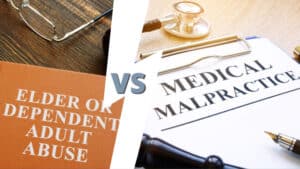Written By: Christopher B. Dolan and Philip Johnson
This week’s question comes from Bronson from San Francisco, who asks: Is there such a thing as an elder abuse restraining order to protect seniors from mistreatment and abuse? If so, who can request one? Can they be someone other than a family member?
Dear Bronson,
Yes, California courts grant elder or dependent adult restraining orders to protect victims of emotional, physical, or financial abuse or neglect. The order can require that someone not contact the elder, keep a certain distance from the elder, move out from the living space they previously shared with the elder, or undergo counseling. The restraining order can sometimes prevent someone from legally owning firearms or ammunition.
An elder is anyone who is at least 65 years old. Elders and dependent adults can request a restraining order to protect themselves. Conservators, trustees, attorneys, guardians ad litem, or county adult protective services workers can also request a restraining order to protect an elder.
To request a restraining order, you must complete several forms listed below. Be sure to make at least three copies of each document to distribute later.
- EA-100 Form: You will tell the judge the details of the elder abuse on this form. You will include what protection you seek and if you need immediate protection. Be detailed in describing the abuse. Start with the most recent incident of abuse or neglect. How often does it occur? When and where does it happen? Offer as many details as you know. As difficult as it will likely be to write, the judge must know what is going on.
- CLETS-001 Form: This document tells the police who they are being asked to restrain. Again, provide as much detail as possible. The person you seek to restrain will not get a copy of this document.
- EA-109 Form: This form is a Notice of Court Hearing. The court will complete most of this document. The applicant will only need to answer the first two parts of this document, which ask who is seeking protection and from whom you seek protection.
- EA-110 Form: This form is required when seeking immediate protection under a temporary restraining order. You can complete this form if necessary.
It is important to note that some county courthouses have their own local forms you must complete. You can find these documents at your local court’s free self-help center, or you can ask the court clerk.
Once the court reviews your documents, they will give you a hearing date on your EA-109 form. In item 5 on Page 2, the form will also tell you the date by which you must serve your papers on the restrained party. Reach out to your county sheriff to arrange service. Once served, the sheriff or marshal should provide you with a Proof of Service form.
On your hearing date, you can submit evidence and present witnesses. Make three copies of all pictures, text messages, emails, or other physical evidence. You must share a copy with the court and another with the person you seek to restrain.
Do appear at your hearing date, even if you need more time to gather evidence. If so, ask the judge at your hearing for more time. Of course, the judge may not grant this request, so be prepared to provide as much information as possible.
Typically, the judge will rule on the day of the hearing. If the judge grants the restraining order, they will likely sign an EA-130 form. On item 16 of that form, you will see if the judge ordered you to serve the restrained party with this document. It is also possible the judge will grant the order but instruct you to fill out the EA-130 form. If so, complete the form and submit it to the court clerk. Ask the court clerk when your form will be ready for you to pick up. The EA-130 form is the restraining order. Make at least two copies, and always keep one with you.









